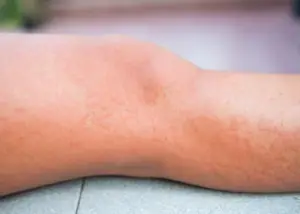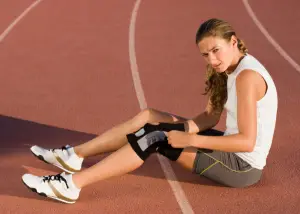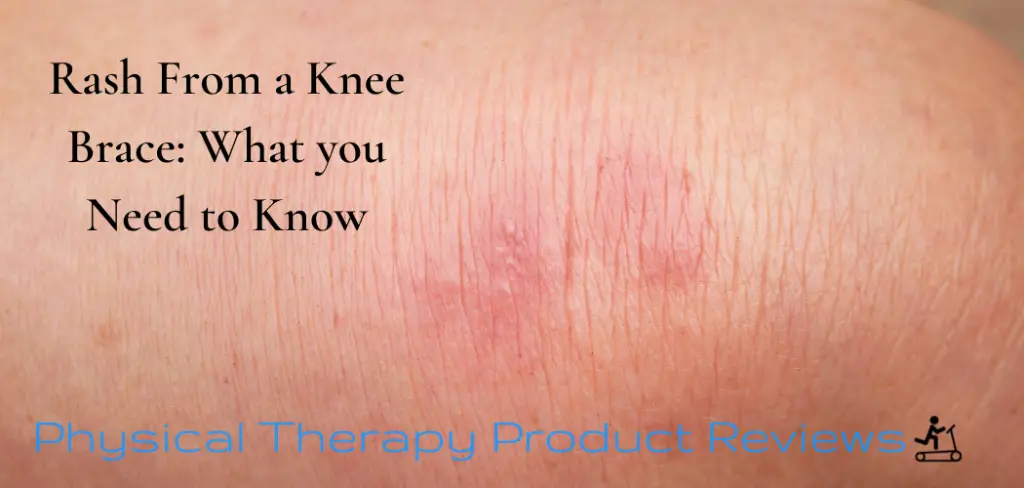Having to wear a knee brace can be awkward and unpleasant enough without having to contend with the discomfort of a rash caused by your brace. Unfortunately, rashes from braces are a common occurrence.
This article will help you to understand why your knee brace is giving you a rash and precisely what you can do to heal and prevent rashes in the future.
Can you Get a Rash from a Knee Brace?
Rashes from knee braces are not uncommon and can become very painful if they aren’t taken care of as quickly as possible. In some cases, a nasty rash can lead people to stop using their knee brace completely, resulting in even greater injury.
Various factors can cause knee brace rashes, so you need to try and work out the most likely reason for your rash. Once you have a good idea of why you have the rash, you can select the best way to get rid of it.

This article will discuss causes, treatments, prevention, and more, so read on to find out all you need to know about rashes caused by a knee brace.
Common Causes of Knee Brace Rash
Allergic Reaction to the Material
The majority of knee braces are made from synthetic plastic or rubber-like materials. Some of the materials used for knee braces can cause an allergic reaction on the skin, also known as allergic contact dermatitis.
Sometimes the reaction to the material can be pretty mild, like a patch of redness or some minor bumps. In more extreme allergic reactions, the area in contact with the brace can become extremely itchy, swollen, and even blistered.
Perhaps the most widely used material for modern knee braces and supports is neoprene, which has been shown to cause allergic contact dermatitis in some individuals. This 2015 study highlights three cases of allergic reactions caused by compounds in neoprene called Thiourea.

To ensure you aren’t allergic to the materials in your knee brace, it is a good idea to wear it for a short time before you put it into proper use. Having the brace contact your skin for around an hour should be enough to see an adverse reaction.
If you have already developed a rash and aren’t sure if an allergy has caused it, try keeping the material in contact with another part of your body for an hour to see if the results are the same.
If your test doesn’t produce a rash, you most probably are not allergic, and your rash has other causes.
Not Cleaning the Knee Brace
Knee braces tend to be used for long periods to support daily activities or for sports and exercise. Either way, the inside of your brace will get coated in sweat, oils, and dirt from your skin.
The dirt from a knee brace can clog and irritate the pores of your skin and result in a rash. Just like any piece of clothing, you need to clean your knee brace regularly.
Improper Fit
A tight-fitting knee brace can cause discomfort, but it tends to be loose braces that cause rashes and irritation.
When a brace is too loose, there will be an increased movement against your skin. A brace that constantly moves during use will eventually scrape your skin and irritate it. A damp brace due to sweating can make the irritation even worse.

A properly fitted knee brace should be tight enough to provide a secure hold around the joint without too much movement between the brace and your skin. Be careful not to overtighten the brace, as you can end up hampering blood circulation.
Your GP or physiotherapist is the best person to ask for advice about fitting your knee brace properly.
Heat Rash from the Knee Brace
Heat rash or “sweat rash” is another common issue for brace-wearers.
In order to provide enough support for your joints, knee braces tend to be made from relatively thick, stiff materials. As a result, the materials used are rarely the most breathable.
The lack of breathability means sweat and heat get trapped inside knee braces quickly, especially during sport or exercise. The trapped heat can lead to a heat rash around the knee, which presents in small, itchy red bumps.

Removing your knee brace when possible to allow ventilation can help reduce the chance of developing a heat rash.
Keeping the area dry will also help so applying talcum powder beneath your brace could be helpful since it will absorb some of the sweat.
How to Get Rid of a Rash from a Knee Brace
Clean the Knee Brace
Keeping your knee brace clean is hygienic and a simple rash-prevention measure. Cleaning your brace isn’t difficult, but you need to make sure you know what materials you’re dealing with before simply throwing it in the washing machine.
In most cases, your brace will come with a set of washing instructions on the tag or inside the packaging. It is always best to follow what the manufacturer recommends.
If you are still unsure of how to clean your knee brace, it is best to keep it on the safe side by handwashing it with the following steps:
- Soak your brace in a bowl of detergent water for around five minutes
- Remove your brace and set it on a dry towel
- Scrub your brace thoroughly with a cloth dipped in detergent
- Rinse your brace under clean water and squeeze out the excess detergent water
- Squeeze and press out as much excess water as you can before leaving your brace to air-dry
Try a Compression Sleeve Underneath to Prevent Chafing
Chafing is caused by the knee brace constantly rubbing against the surface of your skin. Even with a properly-fitted brace, an amount of rubbing and chafing can still occur.
If you are sure your brace is fitted correctly, but you’re still experiencing some chafing, you can try putting a barrier between the brace and your skin.
A standard cotton compression sleeve should do the trick. The compression sleeve itself will be much softer and kinder to your skin than the knee brace.
Take a Break from the Brace to Let your Skin Heal
The easiest and sometimes best step you can take for healing a brace rash is to stop wearing your brace for a while.
By removing the brace, you give your skin the best chance of healing. Once it has healed, you can take preventative measures to minimize the risk of the rash returning once you wear the brace again.
Wear Tights Under the Brace to Prevent Allergic Reactions
Similar to how a compression sleeve can provide a barrier for chafing, wearing tights can do a similar job of stopping allergic reactions.
You might prevent an allergic reaction if your brace doesn’t come into direct contact with your skin. If you can’t find a suitable brace made from a material you aren’t allergic to, wearing tights beneath your brace could be the solution.
How Long Does a Knee Brace Rash Last?
Most rashes should disappear within a couple of weeks, but it can depend on the severity, cause, and various other factors.
Of course, a rash is going to last much longer if you continue to wear your brace before giving it a chance to heal. The best advice for getting rid of a rash quickly is to refrain from wearing a knee brace until the inflammation is under control.
FAQ Regarding Knee Braces and Skin Rashes
Yes, neoprene is highly resistant to water and should not warp or shrink. However, a washing machine could damage seams and stitching, so it is generally best to hand wash a neoprene brace.
It is recommended to regularly wash a neoprene knee brace to prevent the build-up of dirt and bacteria.
Some materials are suitable for machine washing. Always check the label and manufacturer’s guidelines regarding washing a knee brace. If in doubt, hand wash your brace to be safe.
Yes, there are compounds in neoprene that can cause allergic contact dermatitis.
Some knee braces do contain latex. Read labels and product descriptions carefully to determine what materials are used in manufacturing each brace before purchasing.
Conclusion
If you’ve been concerned with a recently developing knee rash then it could be due to your knee brace. It’s important to make sure that your brace fits properly, has been cleaned, and that you test the material on a different part of your body for a possible allergic reaction.
If you do have a slight allergy then we’ve shared some helpful tips such as wearing a cotton knee sleeve to help decrease skin contact. Let us know in the comments below if your knee brace causes a skin rash and what you’ve done to help in the past.
GLP Weight Loss and Back Health: Effective Strategies and Insights
How to Stay Active After Cervical Fractures: Expert Tips and Advice
Dealing with Painful Stairs After Ankle Replacement Surgery
Walking After a Total Ankle Replacement: Tips for a Successful Recovery
Exercises While Non-Weight Bearing After Ankle Replacement: Elevation, AROM, Leg Raises, and More
Ankle Pain with Stairs: Causes and Home Treatment Options
Disclaimer: The information provided in this post is for educational purposes only. This is not a substitute for a medical appointment. Please refer to your physician before starting any exercise program.







